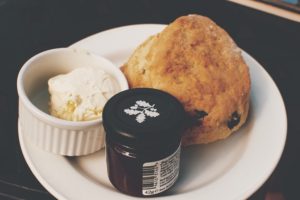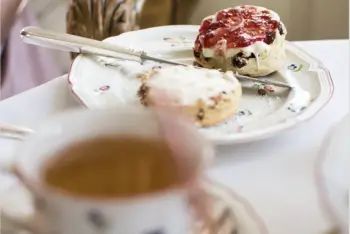Put your calorie counters away for this one. The Cream Tea, much the reserve of the West Country is without a doubt one of the tastiest tourist treats available in the western counties of England.
What is Cream Tea? Also known as Devonshire Cream Tea in the County of Devon or Cornish Cream Tea in Cornwall. An afternoon snack served in local tea rooms. It includes English Breakfast, Scones, spread with lashings of both Clotted Cream and Strawberry Jam. It’s a pure tourist delight. But how did it evolve?
History of Cream Tea
There are records that suggest bread served with Cream and Jam was already around in Devon from as early as the 11th Century in Tavistock Abbey in Devon. Cornwall disputes this and The “Foods of England” website discovered a newspaper cutting, ‘The Cornishman‘ of Thursday, 3 September 1931 (p. 8), which references the use of Cream Tea by a visitor from South Wales
Despite all this, both Devon and Cornwall both lay claim to the invention of Cream Tea. A dispute that will likely never be fully settled.
But we do know that Cream Tea – for both counties, really started to boom following the opening of the Railways in the mid-1850s. Once steam came to town and people could travel to the South West from much further afield, there was a flood of tourists and visitors from the North of England looking to get nearer to the lush beaches and sunshine of the southern counties to relax and recoup.
The idea of sitting in the sunshine partaking of such a new type of treat as a Clotted Cream Tea became very appealing and also very fashionable. The idea has stood the test of time and Cream Tea in Devon, Cornwall, and beyond has maintained its popularity to this day.
Cafes, Tea houses, and as many other establishments that could get on board this new wave of tourism and Cream Tea began to spring up to cater to the thousands of peckish tourists filing past their doors looking for hotels, trails, and beaches.
Now, so popular has Cream Tea become, that Devon Cream Tea was lodged as a protected name in the European Union – and ‘Cornish Clotted Cream’ is a protected name, as long as the clotted cream is produced in Cornwall. Since 2015, there is also now a National Cream Tea on the last Friday in June of each year.
The Difference Between Cream Tea, Afternoon Tea, and High Tea
Cream Tea
First off, for some clarification, Cream tea, Afternoon, and High Tea are not the same and neither is Cream Tea the same as Tea with added Cream instead of milk. Cream Tea is a small ‘snack’ of freshly brewed loose tea, a scone, with a combination of Jam and Clotted Cream. That’s it. The taking of Cream Tea usually only lasts around 30-45 minutes.
Cream Tea is also a more regional food, a specialty of Devon, Cornwall – and maybe spreading to a few surrounding regions. Yes, you can have Cream tea virtually anywhere in the UK, but its real ‘home’ is considered to be in the West Country.
Cream Tea probably has its origins in Afternoon Tea (no one knows for sure) but they were mostly popularised around the same time.
Afternoon Tea

Afternoon Tea is a far more encompassing affair, more of a mid-afternoon meal to keep hunger at bay until the evening meal – which was often around 9 pm in the 1900s.
It includes freshly brewed loose tea, often more than one variety made available to guests.
But also with the addition of finger sandwiches (finger-sized slices of sandwiches) crumpets, cakes, and other small nourishing delights that form part of a more social gathering. Afternoon Tea can take up to 90 minutes or more.
Scones were also served during Afternoon Tea and this is where we may have started to see the transformation that is now Cream tea. Find out more about afternoon tea here
High Tea
This is a spin-off from Afternoon Tea. Upon the arrival and subsequent popularity of afternoon, Tea was not something the working class could take part in, after all, they were working. Plus they could rarely afford an extra meal of the day.
But as Afternoon Tea had become so aspirational they, of course, wanted to get in on the act. Therefore, afternoon Tea became ‘High Tea’. It was still the main meal upon arriving home and often involved more by way of substantial food, so vegetables and light meats such as ham were included.
The differences in the name for Afternoon Tea and High Tea are down to the height of the table upon which they were served. Afternoon Tea often being eaten around occasional tables in drawing rooms. High Tea, being eaten at a dining table – which is higher.
Certainly, High Tea and rarely even Afternoon Tea offers the treat of Clotted Cream!
What is Clotted Cream?
Clotted Cream is typically produced and served in the southwest of England. It’s a smooth thick yellowish cream derived from full dairy milk. The milk is heated slowly using steam or a hot water bath, and allowed to cool, while the cream content rises to the surface in ‘clotted’ lumps (or ‘Clouts’). The cream is then gathered, shaped, and left to set.

When clotted cream is combined with freshly cooked scones and Strawberry Jam, the taste is delightful – and not without its measure of guilt though.
The calorie content of Cream Tea is sufficient to fill half your quota for the day! See our table below…
Cream Tea Calorie Guide
Based on a Medium or Large scone cream tea, with a medium or Large portion of jam and clotted cream:
Here are the related calorie, fat, carbs, and protein levels.
| Calories | Fat | Carbs | Protein | |||||
| Size | Med | Large | Med | Large | Med | Large | Med | Large |
| TOTAL | 820 | 1365 | 42 | 87 | 85 | 189 | 8 | 18 |
| Cream Tea | 390 | 690 | 20 | 50 | 40 | 80 | 4 | 9 |
| Scone | 210 | 350 | 5 | 12 | 30 | 60 | 4 | 8 |
| Jam | 60 | 85 | 1 | 1 | 14 | 24 | 0 | 0 |
| Cream | 150 | 240 | 16 | 24 | 1 | 25 | 0 | 1 |
In either county, there is largely no difference in the way Cream Tea is served. There is a pot of freshly brewed (usually) looseleaf black tea, along with a freshly cooked scone, with Strawberry jam and Clotted Cream. Serving Cream Tea in Devon and Cornwall
The Differences Between Devon Cream Tea and Cornish Cream Tea
In Cornwall, they have Cornish Clotted Cream. In truth both Clotted creams taste very similar – in fact, I couldn’t really tell the difference. In Devon, it is of course, Devonshire Clotted Cream. The Jam is just the Jam. You give the scone a twist to halve it and begin applying the spreads.
It’s the way these treats are assembled that makes the main difference. It’s a cultural difference and a number of scientists have waded in previously to try and provide a scientific ‘Best Method’ – with contradictory results.
Really all things are the same, except in Cornwall, you add the Jam first, then the cream. Whereas in Devon, you add the Cream first and then the Jam. It’s a hotly debated question as to which is the correct way – at least in Cream Tea circles, it is. But nonetheless, most people wouldn’t think either way detracts from its overall enjoyment.
If it helps you to end this debate and if you take the Royal Family to be your etiquette guide. The Queen has been observed adding the Jam before Cream in the Cornish Style.
How to Eat Cream Tea
Given the hot debate over Jam or Cream first, we’ve added both versions to the list. My advice would be to use whichever version you’re in within each county – out of respect. If you’re not in either of these counties, then I spread one for each!
- The person nearest the pot of Tea pours a cup for each person first
- Each person individually then adds their own milk and sugar to their taste
- Hold your Scone over your plate and holding the top and bottom give it a twist. It should break in half
- Add to your plate a good spoon full of cream and a spoon full of jam
- In Devon, Take your knife and spread the cream on each half, then add the jam
- In Cornwall, spread the jam first, then add a spoon full of cream on top
- Enjoy!
We hope this has helped to answer your questions regarding Cream Tea, How to Serve Cream Tea, and the History behind Cream Tea. If we’ve missed anything then be sure to let us know.
